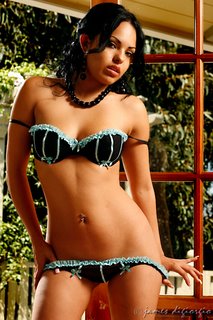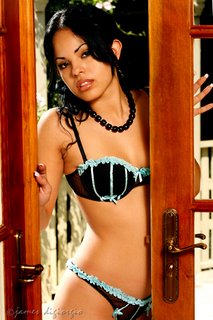 Mixing bright daylight with artificial light can be a challenge, sometimes a big challenge.
Mixing bright daylight with artificial light can be a challenge, sometimes a big challenge. One way to accomplish this, and this technique is most often used when shooting motion picture film or video, is to apply neutral density gels to the windows and knock the daylight down. That's assuming, of course, that windows are the problem.
Unfortunately, the neutral density method is both costly and time-consuming. If the windows are very brightly back-lit and you're shooting in front of them, there are times when using ND filter is all you're left with. It takes a fair amount of artificial light to equal or overcome bright daylight! As you might guess, when shooting video or motion picture film, mixing daylight with artificial light is always a challenge.
 Many film and video productions utilize tungsten light sources. It takes some hefty tungsten lights to overcome bright daylight if it can be done (in a practical way with tungsten) at all. Plus, when mixing tungsten with daylight, you're now confronted with color temperature issues. Sure, HMIs can be employed and they do a great job. They also operate in the same color temperature range as daylight. But not every production has or can afford to have HMIs on the set.
Many film and video productions utilize tungsten light sources. It takes some hefty tungsten lights to overcome bright daylight if it can be done (in a practical way with tungsten) at all. Plus, when mixing tungsten with daylight, you're now confronted with color temperature issues. Sure, HMIs can be employed and they do a great job. They also operate in the same color temperature range as daylight. But not every production has or can afford to have HMIs on the set. When you're on location, power also becomes an issue. The mightier (higher wattage) the light sources, the more power it takes. Since most homes are operating with 15 amp circuits, it's easy to plug a light into a receptacle that drains all those amps and kicks the circuit breakers. Yeah, many productions "tie-in" to the power, circumventing the circuit breakers, but that takes someone who knows what they're doing and, if your shooting legally, i.e., with a permit, you'll need a special and additional "tie-in" permit. Be advised, when you're operating with a "tie-in" permit, there's a good chance someone from the local fire station will stop by to see you've done things right.
With still photography, it's simpler to equalize daylight and artificial light with strobes. Strobes throw out a lot of light without much power consumption. Color temperature is not much of a problem since, like HMIs, strobes operate in the the same color temperature range as daylight.
 When mixing daylight and artificial light, getting some help through the use of a light meter is, in my opinion, almost a neccessity. I suppose you can make an educated guess and then bracket and use your histogram as a guide. But that sounds like a lot of work (and guesswork) when a meter will tell you what you need to know quite quickly and simply. Situations like this, that is, where the model is backlit by bright daylight, will fool most of the automatic exposure functions on your camera and the model will end up under-exposed.
When mixing daylight and artificial light, getting some help through the use of a light meter is, in my opinion, almost a neccessity. I suppose you can make an educated guess and then bracket and use your histogram as a guide. But that sounds like a lot of work (and guesswork) when a meter will tell you what you need to know quite quickly and simply. Situations like this, that is, where the model is backlit by bright daylight, will fool most of the automatic exposure functions on your camera and the model will end up under-exposed.The images I posted along with this are of Victoria. I captured these images a couple of weeks ago. As you can see, I'm mixing daylight with artificial light-- the artificial light being in the form of two monolights with umbrellas. One strobe is inside the home, modified with a large, 48" umbrella. Outside, I used a small umbrella to provide some hairlight and backlight. The sun was overhead when these images were captured. I could have had an assistant with a reflector bounce some light in from behind, but I didn't have an assistant handy. (It was one of those kinds of shoots.)
Model is Victoria. (She did her own makeup: Like I said, it was one of those kinds of shoots.) Images were captured with Canon 5D w/85mm prime. ISO 100, f/8 @ 125th. For color temp, I used the Canon's default white balance for "flash."

6 comments:
great article...but how do you meter in this situation? take an ambient light meter reading then try a 1/3 stop higher for your strobes? i've shot only artificial and daylight but not yet both...thinking it's about time to start! :)
So what is exactly the best method to balance the two? I've shot artificial and ambient but not both. I am assuming that you would meter the ambient and then adjust your lights to provide the same?
what we're dealing with is lighting ratios. the ratio you choose will determine the level of contrast between that which is lit by daylight and that which is lit artificially.
If the ambient daylight is reading f/8 and you can throw f/8 worth of artificial light on your subject, the background (daylight lit) and the subject (artificially lit) will be equally and properly exposed. if you want more contrast between the daylight-lit BG and subject you could, as an example, light the subject to f/5.6 and, if the BG is f/8, you're going to increase the contrast between the two with becaue of the higher lighting ratio.
if you want to use artificial light to create highlights, the light source you're using should probly be in and around a 1/3 stop higher if you want to see those highlights.
So I measure the ambient light with my normal lightmeter, choose my highest syncspeed (so my flash can overpower the background), and see what aperture the background would need for a normal exposure.
Now I decide on the ratio - to have the background darker than the subject. Then I take my flashmeter, adjust the Flash to be 1/3 stop (depending on what ratio I want) hotter than the background, and move the aperture in the camera to ambient+1/3 stop.
Right ?
Now for the question: why doesn't the flashmeter add the ambient light to the measurement? And if it does, how does it know what speed you are shooting ?
why doesn't the flashmeter add the ambient light to the measurement? And if it does, how does it know what speed you are shooting ?
not sure i understand the question. you're reading the daylight with your meter set to ambient. you then read the flash as a flash reading. both are read at the same shutter speed.
In some cases your light meter will tell you the percent of the reading it got from the strobes vs ambient light. I believe most the sekonic meters have that function built in. Nice work once again JimmyD.
Post a Comment